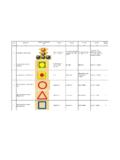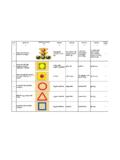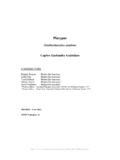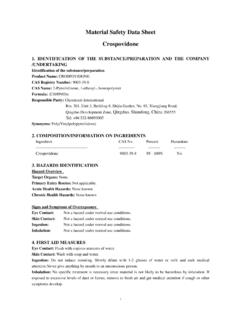Transcription of ENGINE PRIMING FUEL MATERIAL SAFETY DATA …
1 MATERIAL SAFETY data SHEETMSDSENGINE PRIMING FUELP repared: June 3, 2013 Page 1 of 2 SECTION 2 - COMPOSITION/INFORMATION ON INGREDIENTS ACGIH OSHA LC50(4hr) LD50 (mg/kg)Ingredients CAS # % (weight) TLV (ppm) PEL (ppm) ihl, rat* oral, rat* dermal, rabbit*Diethyl ether ..60-29-7 ..55 - 70 ..400 ..400 ..32,000 ppm ..1200 ..>14,200 Heptane ..142-82-5 ..15 - 40 ..400 ..500 ..103,000 mg/m3 ..>15,000 ..N/AvCarbon dioxide ..124-38-9 .. - ..5000 ..5000 ..N/Av ..N/Ap ..N/ApMineral Oil, Petroleum distillates, solvent-refined, light paraffinic.
2 64741-88-4 .. - ..5 mg/m3, for oil mists ..5 mg/m3, for oil mists ..N/Av ..>5000 ..>2000 This MATERIAL is classified as hazardous under OSHA regulations (29 CFR ).SECTION 3 - HAZARDS IDENTIFICATIONT arget Organs: Eyes, skin, respiratory system, central nervous of Exposure: Skin contact, eye contact, and Symptoms of Short-Term (acute) Exposure: Inhalation: May be harmful or fatal if inhaled. Inhalation of vapors or mists may cause dizziness, nausea, headache, incoordination and other central nervous system effects. In very high concentrations, may act as an asphyxiant and cause unconsciousness, respiratory collapse and death.
3 Skin: May cause mild irritation, redness and itching. Frostbite symptoms (numbness, prickling and itching) may be experienced. Eyes: May cause mild irritation. Symptoms may include redness, tearing and stinging. Direct contact may cause freezing of the eye. Could cause eye damage. Ingestion: Ingestion of liquefied gas is unlikely. However, if ingested could be harmful. May cause irritation to mouth, throat and stomach. Symptoms may include nausea, vomiting, diarrhea and other central nervous system effects. If large amounts of MATERIAL are ingested, could cause aspiration into the Effects: Prolonged or repeated skin contact may cause dermatitis (drying and cracking).
4 Conditions Aggravated by Exposure: May aggravate pre-existing skin, eye and respiratory 4 - FIRST AID MEASURESI nhalation: Immediately remove victim to fresh air. Obtain immediate medical Contact: Immediately wash skin with mild soap and water. Avoid prolonged contact by removing and washing any clothing soaked with product. If irritation persists, obtain medical attention Contact: First check the victim for contact lenses and remove if present. Immediately flush eyes with lukewarm water or normal saline solution for at least 15 minutes. Obtain medical : Do not induce vomiting.
5 Obtain medical attention immediately. Guard against 5 - FIRE FIGHTING MEASURESF lammability Classification (OSHA 29 CFR ): Flammable gasSuitable Extinguishing Media: Dry chemical, foam, carbon dioxide, water Combustion Products: Carbon Properties: None data : Sensitivity to Mechanical Impact: Not Sensitive Sensitivity to Static Discharge: May be sensitive to static Flammable Limit (% by vol.): 48 (UEL)Lower Flammable Limit (% by vol.): (LEL)Flash Point (Method): < - 56 F / - C (TCC)Auto-Ignition Temperature: N/AvFire Hazards/Conditions of Flammability: MATERIAL may explode and burn when exposed to heat, sparks and flame.
6 Vapors are heavier than air and collect in low-lying areas. The vapors may travel considerable distances and flashback to a source of ignition. Containers are under pressure and may explode if exposed to excess Fire-Fighting Procedures/Equipment: Firefighters should wear proper full protective equipment and self-contained breathing apparatus. Move containers from fire area if it can be done without risk. Water spray may be useful in cooling equipment and containers exposed to heat and flame. Shield personnel to protect from venting, rupturing or bursting cylindersSECTION 6 - ACCIDENTAL RELEASE MEASURESP ersonal Precautions: Restrict access to area until completion of clean-up.
7 Ensure clean-up is conducted by trained personnel only. All persons dealing with clean-up should wear the appropriate chemically protective equipment. Keep all other personnel upwind and away from spill/release. Also see Section 8, Exposure Controls/Personal Precautions: Ensure spilled product does not enter sewers or confined Response/Cleanup: Eliminate all sources of heat, sparks and flame. Ventilate area of release. Stop leak if you can do so without risk. Carbon dioxide may be used as a precautionary vapor blanket. For small amounts of spilled MATERIAL , flush with water. Notify the appropriate authorities as required.
8 Prohibited Materials: None Spill Response Procedures: If a spill/release in excess of EPA reportable quantity is made into the environment, immediately notify the national response center in the (phone: 1-800-424-8802).EPA/CERCLA Reportable quantity (RQ): Diethyl ether (100 lbs.)SECTION 7 - HANDLING AND STORAGESafe Handling Procedures: Read all cautionary information on cylinder and use only in accordance with directions. Wear protective equipment during handling, as applicable. Use in a well ventilated area. Avoid inhaling vapors or mists. Avoid contact with eyes, skin and clothing.
9 Do not use near sources of heat, flame, sparks or ignition sources. Do not puncture or incinerate containers. Keep away from Requirements: Store in a cool (< 120 F / C), dry, well-ventilated area away from incompatibles, heat, flame, sunlight, sparks or ignition sources. No smoking in the 8 - EXPOSURE CONTROLS AND PERSONAL PROTECTIONV entilation and Engineering Controls: Use in well ventilated area. Ventilation must be sufficient to maintain vapors at level which is below listed TLV s, particularly at floor level as vapors are heavier than air. Respiratory Protection: For prolonged exposure or if the TLV is exceeded, wear NIOSH-approved Protection and Other Protective Equipment: Not normally required.
10 For prolonged exposure, insulated gloves impervious to the MATERIAL , such as Nitrile, Viton, PVA, or Butyl are recommended. An eyewash station should be made available in the immediate working / Face Protection: Wear SAFETY glasses or goggles to prevent any vapors or mists from entering the Hygiene Considerations: Avoid contact with eyes, skin and clothing. Do not eat, drink or smoke while handling product. Avoid excessive breathing of OVERVIEW: Pale yellow to clear liquid, strong ethereal odor, evaporates quickly, leaves slight lubricant residue. WARNING! Extremely flammable. Contents under pressure.





